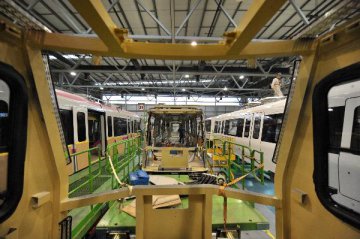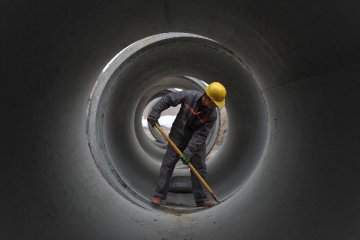
Ten sorts of pilot reforms for state-owned enterprises (SOEs) was first disclosed yesterday at the news press jointly held by the State-owned Assets Supervision and Administration Commission (SASAC), the National Development and Reform Commission (NDRC) and the Ministry of Human Resources and Social Security (HRSS). Experts in state-owned assets area indicated that state-owned asset and SOE reforms have entered a more systematic implementation phase, and in-depth reform is expected as the pilots are unveiled.
Ten sorts of pilot reforms started
The ten sorts of pilot reforms generally include the following: 1) implement the power of the board of directors; 2) recruit manager on a market-basis; 3) adopt professional manager system; 4) reform on differentiation of salary distribution in enterprises; 5) state-owned capital investment and operating companies; 6) merging and reorganization of central SOEs; 7) mixed ownership reform in some key areas; 8) employee stock ownership in mixed ownership enterprises; 9) information disclosure work of central SOEs; 10) strip social functions committed by SOEs and solve problems left over by history.
There are quite a lot of highlights in the pilot reforms announced at the news press yesterday: the SASAC will select three to five enterprises as pilot enterprises for state-owned capital investment and operating, and promote China Chengtong Holdings Group Ltd. and China Reform Holdings Corporation Ltd. to restructure as state-owned capital investment and operating company; select pilot demonstrations in monopolized industries such as power, petroleum, natural gas, railway, civil aviation, telecommunication and military industry, and determine the first batch of pilot enterprises in the first half year; simultaneously carry out employee stock ownership pilot, and designate ten subsidiaries of the central SOEs and instruct each province and municipality to select ten local SOEs for pilot reforms during the year; select another three to five SOEs for the pilot reform of the power of the board of directors; continue to push forward central SOE merging and reorganization.
Though pilot enterprises are not named in one go, “after further submission and approval, we will publish the detailed list of pilot enterprises as soon as possible,” Zhang Xiwu, deputy director of the SASAC of the State Council revealed at the news press. Li Jin, chief researcher at the China Institute for Small and Medium Enterprises, believes that the SASAC’s initiative of naming just two pilot enterprises at present and then add more step by step is sort of cautious, and subsequent progress are worthy of expecting.
Build two major state-owned capital investment and operating companies
Reform on the supervision system of the state-owned capital represented by investment and operating companies has been the highlight of this round of state-owned capital reform. In 2014, the SASAC chose China National Cereals, Oils and Foodstuffs Corporation (COFCO) and State Development & Investment Corporation (SDIC) as pilot enterprises for state-owned capital investment, but the state-owned capital operating pilot has not started yet. At yesterday’s news press, authority announced that it will promote China Chengtong Holdings and China Reform Holdings to restructure as state-owned capital operating company; besides, the SASAC will determine three to five SOEs as pilots for state-owned capital investment enterprises.
It is noteworthy that current state-owned capital investment and operating companies are all restructured based on the existing central SOEs, and none is newly established. “According to the top-level design, we should not rule out the possibility that new state-owned capital investment and operating companies may be established,” Zhang Xiliang, a senior state-owned assets and SOEs reform expert and researcher told the reporter in an interview.
The reporter noticed that China Chengtong Holdings and China Reform Holdings are likely to become new pilot enterprises. In these two central SOEs, China Chengtong Holdings held multiple companies listed on A-share market, including CMST Development Co., Ltd. (600787.SH), Guangdong Guanhao High-Tech Co., Ltd. (600433.SH), Yueyang Forest & Paper Co., ltd. (600963.SH) and MCC Meili Paper Industry Co., Ltd. (000815.SZ). In comparison, China Reform Holdings has a relatively short history and hence is a little bit mysterious. Established in December 2010, it is the “little brother” in the list of 106 central SOEs. The original purpose of its establishment is to specially optimize the layout structure of central SOEs, and serve as an enterprise operating platform for state-owned assets operating and management. It was even called “the second China Investment Corporation”. Last October, the company spent tens of billions yuan to become the shareholder of China Tower Co., Ltd.
Re-design the hierarchy establishment of state-owned assets supervision body
Li told the reporter that an important task of this year’s SOE reform is to change the existing two-level state-owned assets management structure into three levels: state-owned assets supervision body, state-owned capital investment and operating company and operational SOE. The ultimate goal is to separate government functions from enterprise management, and transform the function of the SASAC from assets management to capital management.
Experts believe that from the revealed information, state-owned assets regulators will transform themselves into “shareholders” along with the implementation of pilot reforms. Their relationship with SOEs will gradually turn into that between shareholder and companies. For this purpose, state-owned assets regulators will make significant adjustments to themselves. This is a signal released by the SASAC at the meeting of the heads of central SOEs in 2016. The SASAC is studying and working on internal organizational settings and function adjustment plan, and will make big adjustments to the organizational structure.
How should state-owned capital investment and operating companies allocate assets? Take the SDIC, which is among the first batch of pilot enterprises for example, “By 2020, the SDIC will form four strategic business units: basic industry, forward-looking strategic industry, financial and service industry and global business,” its chairman Wang Hui recently indicated at a seminar introducing the progress of the reform. In his opinion, state-owned capital should focus on key industries and industries concerning people’s livelihood.
Promote mixed ownership reform of monopolized industry
Besides the state-owned assets system reform, what is closely related with capital market should be restructuring and mixed ownership reform. “Merger and reorganization of central SOEs are focuses of the SOEs reform and China will keep efforts on merger and reorganization unchanged in this year so as to make more achievements.” disclosed by Zhang Xiwu yesterday.
Zhang Xiwu indicated that SASAC and other relevant departments restructured 12 central SOEs and organized 3 telecommunication enterprises to finish establishment of iron tower companies. Through the above work, they made primary exploration on the sharing, competition and cooperation mode represented by tower companies, industrial chain vertical integration mode represented by State Power Investment Corporation, and industrial chain horizontal mode represented by CRRC Corporation Limited. For the next step, they will probe into more effective approaches to do well in the merger and reorganization of central SOEs.
Pilot for mixed ownership reform is expected to extend from commercial field to monopolized industry. Zhang Xiwu said: “The state-owned assets are relatively centralized in power, petroleum, natural gas, railway, civil aviation, telecommunication and military industries. It is widely believed that some of these fields are monopolized by the SOEs. Therefore, it is of great significance to conduct mixed ownership reform pilot demonstration in these fields. Introducing diversified investment with non-state-owned assets to form a governance structure and operation mechanism which is good for participation in market competition will facilitate the development of relevant industries.”
Three obvious changes emerge
“With the central government putting forth efforts in promoting supply-side reform, the ten sorts of pilot reforms have included some new issues, especially the pilot of merger and reorganization of central SOEs, making the pilot rich in content, extensive in coverage and more specific,” Li told the journalist yesterday, adding that there are three changes between the ten sorts of pilot reforms and the first batch of pilot. The first change is that after the top-level plan was launched, the deployment on SOEs reform became more comprehensive with clear highlight, rich content and extensive coverage. Secondly, this round of reform is implemented under the background of supply-side reform and the 13th Five-year Plan. Thirdly, the pilot reforms are more specific after some new issues of the SOEs reform are included.
Translated by Adam Zhang and Vanessa Chen























Latest comments